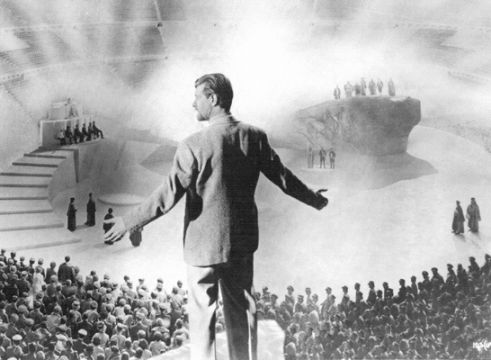A Matter Of Life And Death

Synopsis
When a young airman miraculously survives bailing out of his aeroplane without a parachute, he falls in love with an American radio operator. But the officials in the other world realise their mistake, and despatch an angel to collect him.
“After two poorly received films, A Canterbury Tale (1944) and I Know Where I'm Going! (1945), Powell and Pressburger restored their reputation with this, their most romantic and magical film to date.
Begun towards the end of the war as a propaganda exercise to encourage Anglo-American understanding, A Matter of Life and Death (1946) follows young airman and would-be poet, Peter Carter, who in the last days of the war miraculously survives when he bails out of his damaged plane without a parachute. By the time the Next World realises its mistake, Peter has fallen in love. The film culminates in a vast heavenly trial, in which Peter's counsel, Dr Reeves, defends his client and England against the prejudice of the prosecution, an American schoolteacher who was the first to fall in the American War of Independence.
Alongside the leads Niven and the unknown Kim Hunter (whose brief appearance in A Canterbury Tale was edited out of the British release), Powell cast favourites Roger Livesey, Raymond Massey and Marius Goring in supporting roles. The task of realising the epic vistas of the next world fell to esteemed art director Alfred Junge, whose long association with Powell began with 1933's The Fire Raisers, and cinematographer Jack Cardiff, who would stay with the Archers – and win an Oscar – for their next film, Black Narcissus (1947).
AMOLAD (as the Archers themselves referred to it) was the duo's first use of colour stock since 1943's The Life and Death of Colonel Blimp, and they were determined to use it creatively. They came up with the idea of mixing colour and black and white to differentiate the two worlds.
This wasn't a completely new idea – earlier films, notably The Wizard of Oz (US, d. Victor Fleming, 1939), had effectively combined colour and black and white. But the Archers' ploy was to reverse the logic of that film – in which the fantasy sequences appeared in colour, while prosaic reality is rendered in shades of grey – making the earthbound scenes in Technicolor, with the 'heavenly' sequences in black and white or, more properly, monochrome. In this way the film contrasts the energy and vitality of life and love with the slightly musty sterility of the 'next world' – as the gloriously camp Conductor 71 (Marius Goring) puts it on his first arrival on Earth, "One is starved for Technicolor up there".” – Mark Duguid
Republished with kind permission from the BFI: www.screenonline.org.uk/film/id/438732/index.htmlTechnical Specs
Year: 1946
Duration: 100 min
Alternate Title: Stairway To Heaven